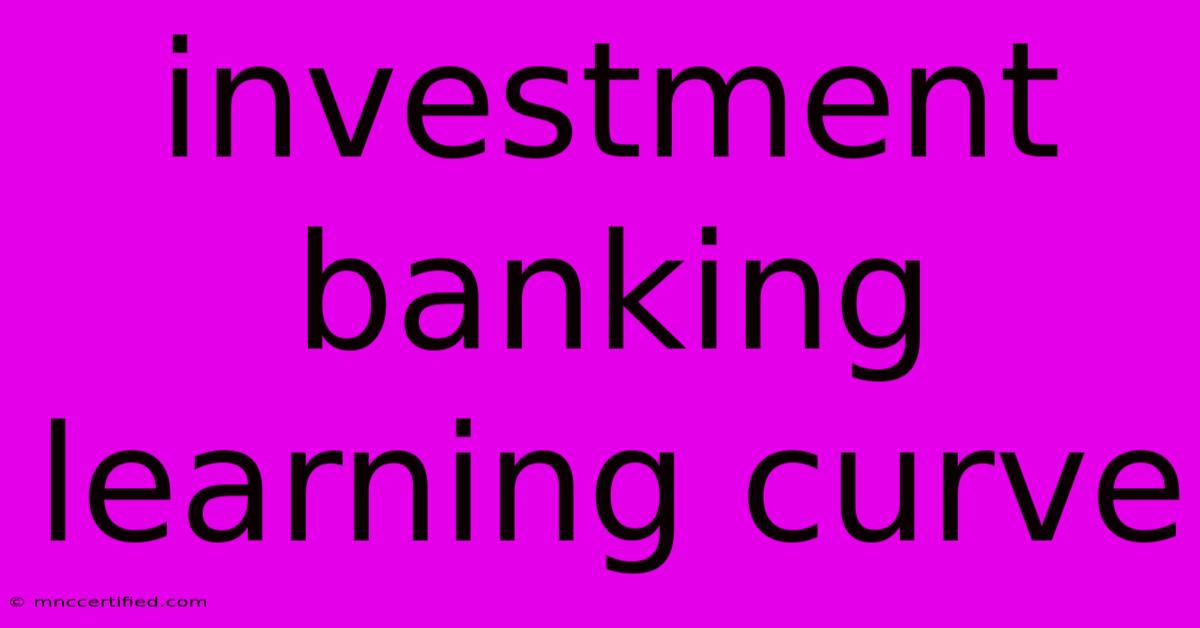Investment Banking Learning Curve

Table of Contents
Navigating the Steep Learning Curve of Investment Banking
Investment banking: a career path synonymous with prestige, high earning potential, and… a brutally steep learning curve. While the rewards are undeniably enticing, the journey to becoming a successful investment banker is demanding, requiring intense dedication, rapid learning, and exceptional resilience. This article explores the key aspects of this learning curve, providing insights for aspiring and current professionals.
The Initial Shock: Immersion in a High-Pressure Environment
The first few months in investment banking are often described as a "baptism by fire." New analysts are plunged into a fast-paced, high-pressure environment characterized by:
- Intense Workload: Expect long hours, often exceeding 80-100 hours per week, especially during peak seasons. This isn't just about working hard; it's about working smart and efficiently.
- Complex Financial Modeling: Quickly mastering advanced financial modeling techniques, including discounted cash flow (DCF) analysis, leveraged buyout (LBO) modeling, and merger arbitrage, is crucial. This requires a strong foundation in accounting, finance, and valuation principles.
- Steep Technical Learning Curve: You'll encounter a constant stream of new concepts, acronyms, and industry jargon. Effective learning strategies are key to keeping up.
- Client Interaction (Indirectly at First): While direct client interaction may be limited initially, understanding client needs and the broader implications of transactions is paramount.
Mastering the Fundamentals: Key Skills to Focus On
Successful navigation of this initial phase hinges on:
- Technical Proficiency: Develop strong skills in financial modeling, accounting, valuation, and corporate finance.
- Analytical Skills: Hone your ability to analyze complex financial data, identify key trends, and draw insightful conclusions.
- Time Management: Master the art of prioritizing tasks, managing your time efficiently, and working under tight deadlines.
- Attention to Detail: Accuracy is paramount. A small error in a financial model can have significant consequences.
The Mid-Game: Specialization and Relationship Building
As you gain experience, the learning curve shifts towards specialization and relationship building:
- Industry Specialization: You might focus on specific sectors (e.g., technology, healthcare, energy) or transaction types (e.g., mergers and acquisitions (M&A), initial public offerings (IPOs), debt financing).
- Mentorship and Networking: Building strong relationships with senior bankers and colleagues is essential for learning, career advancement, and gaining valuable insights.
- Presentation and Communication Skills: Effectively communicating complex financial information to clients, colleagues, and senior management is crucial.
- Deal Execution: Active participation in deal execution—from initial client interaction to closing—is key to developing practical experience and understanding the entire process.
Developing Essential Soft Skills: The Unspoken Secret
Beyond technical skills, soft skills play a critical role in long-term success:
- Resilience: The ability to handle pressure, overcome setbacks, and maintain a positive attitude is crucial.
- Teamwork: Investment banking is a team sport. Collaboration and communication are essential for success.
- Adaptability: The industry is constantly evolving, so adaptability is key to staying relevant.
- Proactive Learning: Continuously seek out new knowledge and development opportunities.
The Endgame: Leadership and Strategic Thinking
Reaching senior levels demands a different set of skills:
- Strategic Thinking: Developing a high-level understanding of market dynamics, industry trends, and competitive landscapes is essential for strategic decision-making.
- Leadership and Mentorship: Guiding and mentoring junior bankers becomes a key responsibility.
- Business Development: Cultivating and managing client relationships becomes increasingly important for securing new business.
- Deal Origination: Identifying and pursuing new deal opportunities is a hallmark of senior investment bankers.
Continuous Learning: A Lifelong Pursuit
The learning curve in investment banking is not a destination; it's a journey. Continuous professional development, staying abreast of industry trends, and adapting to market changes are vital for long-term success.
Conclusion: Embrace the Challenge
The investment banking learning curve is undoubtedly steep, but the rewards for those who persevere are significant. By focusing on developing a strong foundation in technical skills, cultivating essential soft skills, and embracing a commitment to continuous learning, aspiring and current professionals can successfully navigate this challenging yet rewarding career path. Remember, persistence, adaptability, and a genuine passion for finance are key ingredients for success.

Thank you for visiting our website wich cover about Investment Banking Learning Curve. We hope the information provided has been useful to you. Feel free to contact us if you have any questions or need further assistance. See you next time and dont miss to bookmark.
Featured Posts
-
Investir Immobilier Saint Nazaire
Nov 20, 2024
-
Oklahoma City Investment Property
Nov 20, 2024
-
Fidelity Investments Vs Tiaa Cref
Nov 20, 2024
-
Technology Insurance Workers Comp
Nov 20, 2024
-
Univista Insurance San Antonio Tx
Nov 20, 2024